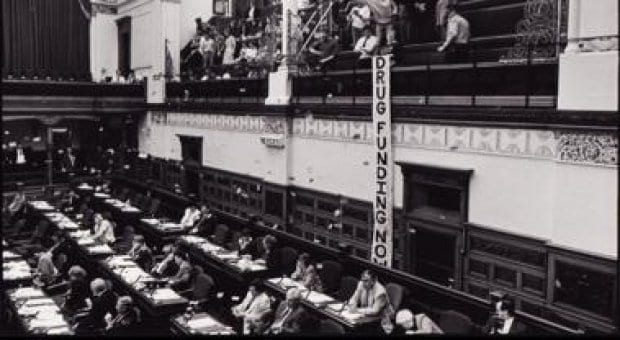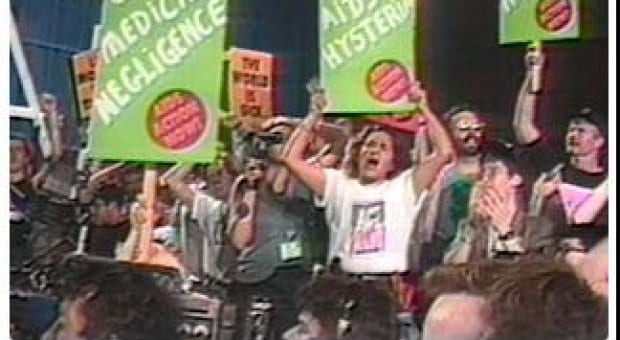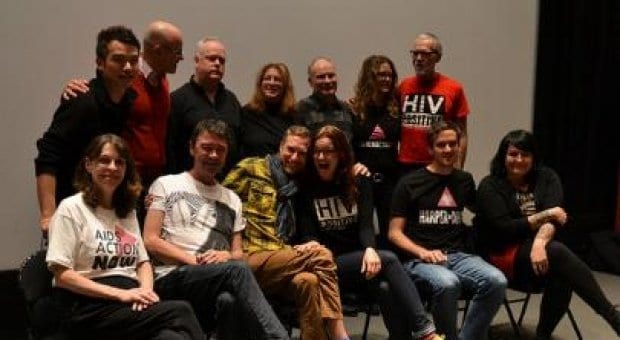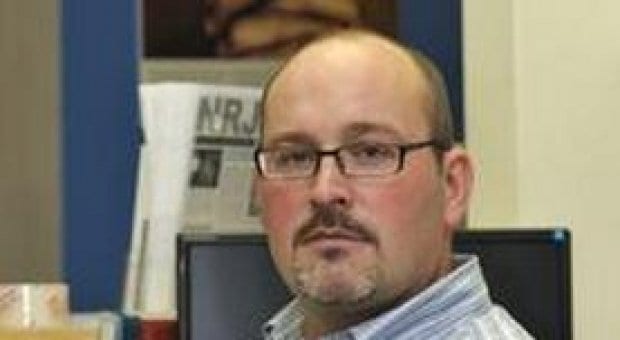
Members of AIDS Action Now unfurl a banner at Queen's Park. Credit: Jake Peters

AIDS activists from New York and Toronto storm the stage at the 1989 International AIDS Conference in Montreal. Credit: Courtesy of catie.ca

Two generations of AIDS Action Now onstage at the group's 25th anniversary event at the Art Gallery of Ontario, Nov 27. Credit: Andrea Houston
Toronto’s response to the 1980s AIDS crisis was fast and fierce compared to other places. Those years turned average people into activists who courageously worked to change Ontario’s health policies and save countless lives.
That history is being honoured by the Canadian HIV/AIDS Legal Network (CHLN) Dec 4 at the 11th annual Awards for Action on HIV/AIDS and Human Rights. The event will look back on 30 years of activism and put the spotlight on those who fought for the rights and dignity of people with HIV.
“The AIDS movement should be extraordinarily proud that it really broke the mould for patient advocacy. It broke down the doors that were closed, making HIV-positive people part of the discussion with a seat at the table. It was about empowerment,” says Richard Elliott, executive director of the legal network.
“But, what’s most disheartening is, 30-plus years into the history of this disease, we’re still dealing with the same misinformation, fear and stigma.”
Toronto first confronted AIDS in 1982, when local gay men began getting sick. AIDS had entered the public consciousness the previous year as a “rare cancer” in 41 gay men in New York and San Francisco.
In 1983, after a meeting hosted by the Hassle Free Clinic and Gays in Health Care, a small group of community activists formed the AIDS Committee of Toronto (ACT) to respond to the growing hysteria and misinformation surrounding the disease.
ACT — marking its 30th anniversary in 2013 — became the province’s first AIDS service organization.
John Maxwell, director of programs and services for ACT, says the committee never wavered on the idea that people with AIDS can have healthy and fulfilling sex lives. “Even in those early years when it was a really scary unknown disease. In the States, they were closing bathhouses. We chose to inform ourselves as a community.”
Meanwhile in New York, the artists and anarchists of ACT UP (AIDS Coalition to Unleash Power) were staging media-savvy demonstrations, demanding “drugs into bodies” and drawing a link between homophobia and inaction on AIDS.
It was that energy that a group of mostly HIV-positive people in Toronto tapped into in 1987 in forming AIDS Action Now (AAN), which recently marked 25 years of activism.
Surrounded by death, and raw with anger, the community wanted action, says Tim McCaskell, the last surviving member of the original HIV-positive founders.
“There was a lot of resentment building against ACT, because ACT was doing social services, education around safe sex and support groups, and people felt that it should be doing other things. It should be doing more,” he says. “By that point ACT was receiving a bit of government funding and it wasn’t in the position to bite the hand that fed it.”
Maxwell says AAN allowed for a division of labour among activists and prevented much of the infighting seen with ACT UP.
“[Separating ACT from AAN] was deliberate,” he says. “We wanted to shift the advocacy to AIDS Action Now. Divide and conquer is a great way to stop a movement. We saw what was happening in New York. We didn’t want to go down that road.”
In 1987, when AAN was founded, activists hung posters in the Village directing people to an emergency meeting at Jarvis Collegiate. More than 400 attended.
“The energy in the room was electric,” says original AAN member Glen Brown. “It was a powerful meeting . . . We were certainly inspired by ACT UP.”
McCaskell says people recognized the need to begin lobbying politicians to pressure governments, drug companies and other institutions to secure improved treatment. From the beginning, it was decided AAN would not accept any funding from government or the pharmaceutical industry.
“We figured out that this wasn’t just a virus that was killing us. It was that no one was doing fucking anything,” he says.
Even medical staff in hospitals worked under a cloud of ignorance and fear, McCaskell says. “Nurses were wearing space suits, not delivering meals, not cleaning out bed pans because they were afraid to go into patients’ rooms . . . It was awful.”
Setting standards of care, figuring out the science surrounding the disease and getting access to experimental treatments became early goals. “None of us were scientists. We were professors, political geeks and community organizers,” McCaskell says.
Some joined AAN after they were diagnosed with HIV and soon after experienced a radical shift in their personal politics. McCaskell recalls “one Tory closet case who got AIDS.” His friends had all abandoned him, and he suddenly realized the system he had fought for his whole life wasn’t working. “There were all these people who would have never got involved in activism working side by side with seasoned activists.”
A watershed moment for AAN came in 1989 during the International AIDS Conference in Montreal. AAN joined forces with ACT UP New York to seize the stage.
“ACT UP didn’t tell us this was the plan,” McCaskell describes. “They just barrelled through security and up the elevator. The prime minister was backstage waiting for his moment of glory. The next thing I knew, all of us were looking at the audience on stage and chanting.”
Some people cheered, but most just stared at the stage, blinking, he says. “People were gobsmacked. In those days AIDS conferences were mostly government officials, doctors and scientists.
“After that, conference organizers realized they could never organize one of these things without taking into account people with AIDS and providing a space for activists.”
In Toronto, other community support groups were founded to support specific communities that were disproportionately affected by the disease, such as the Black Coalition for AIDS Prevention, the Gay Asian AIDS Project and the Toronto People with AIDS Foundation (PWA).
“More of these groups started popping up, but they stayed focused on treatment and research,” McCaskell says. “In the beginning it was just gay men, and most of us were white. Then people of colour, women and straight men started to get infected.”
On the political stage, Prime Minister Brian Mulroney was doing his best to ignore the disease, he says. “So every time Mulroney came to town we made sure his life was really miserable.”
The “die-in” became an important part of AAN’s arsenal. “You haven’t seen a die-in until you’ve seen a contingent of drag queens do a die-in,” says Brown.
In Ontario, more new drugs were being made available, but without a drug card, few could afford treatments. “The majority of gay men who were infected had the stereotypical gay occupations: the waiters, the actors, the artists, the students. None had medical plans,” McCaskell says.
People faced a desperate situation, forced to quit their jobs, impoverish themselves and go on welfare for the medical benefits. “They could barely afford to feed and cloth themselves or keep an apartment.”
The introduction of the Trillium Drug Plan changed that. And much of the credit goes to AAN. “That was the result of four years of us attacking and harassing the NDP government. It was the last piece of legislation they introduced. That was a huge victory that changed the social terrain of the entire province for people with all sorts of diseases,” McCaskell says.
In 1992, the HIV/AIDS Legal Network was established by a group of Montrealers who recognized the need to understand the legal dimensions of the disease. CHLN started to advocate for public policy that would promote the human rights of people living with and vulnerable to HIV/AIDS, in Canada and around the world.
“From those early days, we saw the response to AIDS so profoundly marked by stigma, prejudice and fear,” Elliott says. “These were communities that were on the margins that did not enjoy the political support that was needed. The human rights dimension of the disease was stark from the very beginning.”
Since HIV testing began in late 1985, 20,000 people have tested positive for HIV in Toronto, according to ACT.
From 2006 to 2010, Toronto Public Health reported steady declines in new reported HIV cases, followed by a 10 percent increase in 2011.
Rita Shahin, associate medical officer of health, says public health works with activists on a number of fronts, such as anonymous testing, HIV criminalization, disclosure and harm reduction.
She says sexual health outreach and sex education need to improve. “Some people feel AIDS is less of a life-threatening illness because the drugs are so good. There’s more complacency. People don’t feel it’s an urgent issue. That would be wrong.”
Shahin says working with the “current administration” at city hall has been challenging. “Cost containment is concerning right now.”
Mayor Rob Ford has a well-documented history of making disparaging comments about people with AIDS, and he has consistently voted against funding for HIV programs. Last year, Ford threatened dramatic cuts to all city-run prevention and support groups, including ACT. Activists fought the cuts and won.
McCaskell feels history is repeating itself. Rather than seeing laws begin to improve, activists are struggling to hold on to what they’ve fought for. “If [Tim] Hudak wins in Ontario in the next election, that would be a nightmare scenario: three levels of conservative government in Toronto.”
In August, the Harper government cut two thirds of CHLN’s funding under Canada’s federal AIDS strategy because some of CHLN’s work involves advocacy.
The CHLN makes no secret of its advocacy work – it works to mobilize and educate those living with HIV about their rights and takes positions on government policy. The legal network played a big role in fighting for C-398, which was recently defeated in the House of Commons.
“We’re still swimming against fear, deep-rooted prejudices and misinformation,” Elliott says. “Also, the people affected by HIV are consistently not of primary concern to people in positions of power, who can make laws and change things for the better. These are still considered communities that don’t matter: gay men, sex workers, injection drug users, people in poverty, people of colour.
“But mainly, just follow the money. Moneyed interests have a great deal of clout with lawmakers, and that is no small thing.”

 Why you can trust Xtra
Why you can trust Xtra


